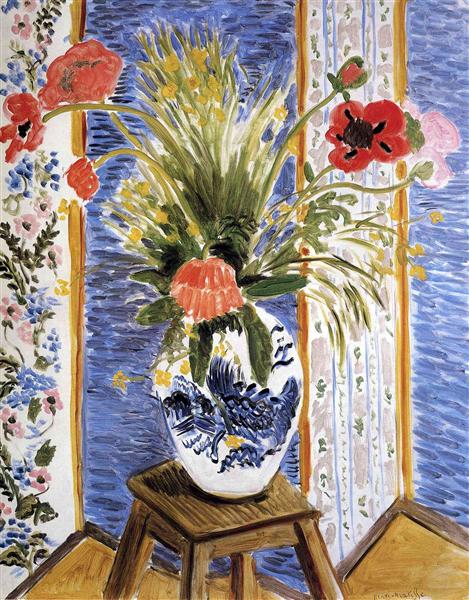Description
In the painting "Poppies" from 1919, Henri Matisse invites us to delve into a world of serenity and vitality through the representation of poppy flowers. Matisse, a titan of modern art and a central figure of Fauvism, brings us in this work a mastery in the use of color and simplification of forms that define his characteristic style.
At first glance, "Poppies" presents itself as an apparently simple composition, but brimming with harmony and life. The painting is dominated by a vase full of red poppies that rise with grace and robustness. The flowers, with their open petals and intense red, are a clear example of the expressive use of color that Matisse developed throughout his career. The poppies seem to almost float within the composition, standing out vibrant and full of energy.
The choice of color is undoubtedly one of the most notable aspects of this work. Matisse uses a background of blue and turquoise tones that act as a perfect contrast to highlight the red of the poppies. The use of color not only seeks visual beauty but also communicates feelings of tranquility and calm. This contrast between the cool background and the warm colors of the flowers achieves a surprisingly balanced and distinctively pleasing visual effect.
The structure of the composition is equally intriguing. The lines and shapes in "Poppies" reflect the influence of both classicism and modernist innovation. The arrangement of the flowers within the vase does not follow a strictly naturalistic logic but rather approaches an orderly disorganization that is an unmistakable hallmark of Matisse. This twist creates a dynamism and a sense of movement that seems almost musical.
Besides being an effective exploration of color and form, "Poppies" can be seen as a statement of appreciation for nature and simplicity. Throughout his life, Matisse was drawn to the beauty of the everyday and captured that essence in his works. This painting, in its apparent simplicity, achieves a depth and sophistication that speaks directly to the viewer, creating an emotional connection.
It is important to frame "Poppies" within the historical and personal context of Matisse. Painted in 1919, around the end of World War I, the artist sought refuge in his art to find peace and beauty, distancing himself from the chaos and destruction that the world was witnessing. In this sense, the poppies can be seen not only as an aesthetic exploration but also as a symbol of hope and rebirth.
Matisse, with his work, always challenged conventional notions of art. "Poppies" is a testament to his ability to transform the ordinary into the extraordinary, and in this painting, we can clearly see why he is considered one of the greatest masters of 20th-century art. His ability to imbue each brushstroke with life and expression is unparalleled, and in "Poppies," he leaves us a legacy that celebrates the beauty and simplicity of nature, inviting us to see the world through his unique and vibrant perspective.

